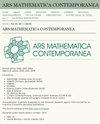几乎所有的Cayley映射都是正则表示
IF 0.9
3区 数学
Q3 MATHEMATICS
引用次数: 0
摘要
Cayley图是建立在群上的Cayley图上的组合结构。因此,原始群嵌入到它们的自同构群中,人们可以问在什么情况下这两个是重合的(然后人们把Cayley映射称为映射正则表示或MRR),以及有多大的概率。第一个问题由杰伊回答。在本文中,我们处理了概率版本,并证明了随着群体变大,所有Cayley地图中mrr的比例接近1。本文章由计算机程序翻译,如有差异,请以英文原文为准。
Almost all Cayley maps are mapical regular representations
Cayley maps are combinatorial structures built upon Cayley graphs on a group. As such the original group embeds in their group of automorphisms, and one can ask in which situation the two coincide (one then calls the Cayley map a mapical regular representation or MRR) and with what probability. The first question was answered by Jajcay. In this paper we tackle the probabilistic version, and prove that as groups get larger the proportion of MRRs among all Cayley Maps approaches 1.
求助全文
通过发布文献求助,成功后即可免费获取论文全文。
去求助
来源期刊

Ars Mathematica Contemporanea
MATHEMATICS, APPLIED-MATHEMATICS
CiteScore
1.70
自引率
0.00%
发文量
45
审稿时长
>12 weeks
期刊介绍:
Ars mathematica contemporanea will publish high-quality articles in contemporary mathematics that arise from the discrete and concrete mathematics paradigm. It will favor themes that combine at least two different fields of mathematics. In particular, we welcome papers intersecting discrete mathematics with other branches of mathematics, such as algebra, geometry, topology, theoretical computer science, and combinatorics. The name of the journal was chosen carefully. Symmetry is certainly a theme that is quite welcome to the journal, as it is through symmetry that mathematics comes closest to art.
 求助内容:
求助内容: 应助结果提醒方式:
应助结果提醒方式:


